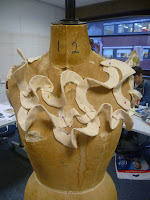The beginning of my sketchbook is made up of drawings I did when I visited the Botanical collection at Manchester museum. I actually feel that I could have done a lot more initial visual research as I don’t have many drawings to really work from and become inspired by here. The drawings I have done I am quite pleased with, I employed various line drawing methods; I do wish I had used some colour though, as the only colour I worked from were those that were taken from photographs that I took during this visit.
In my sketchbook I feel that I’ve quite clearly displayed my sample work, especially from the hand processes workshops that I attended. As they are too bulky to actually put in my sketchbook, they’ve been shown through photographs. I like how I have worked with these photos, and incorporated my own sketching into them, or combined them with other photos to clearly show how I could work with them.
I haven’t made many annotations in my sketchbook towards the start, but later on when it perhaps becomes more complex in how I wish to show my ideas I have made more notes. I feel this makes the sketchbook flow pretty well to my audience, I am hoping that my thoughts and ideas throughout the project are clear and understandable.
I am happy with the various methods I used in my drawings – I didn’t just stick to traditional drawing materials. I worked with texture and colour, and I think that these also tie in with my botanical study too.
Although I have done some contextual research and looked at some artists and designers, I could have done a little more. The things I have looked at, though, have good relevance to my work and have helped me with my development of ideas, sampling and design work.
Within my sketchbook I have tried to keep the layouts interesting and I enjoyed working on various different backgrounds, prepared papers and different scales. This makes the sketchbook more interesting for others also. The prepared backgrounds also made it easier for me to work onto; with new sketchbooks I am often a little apprehensive about working onto a bright white page!
Overall I’m pleased with my sketchbook work, however I do feel it could be a little more in depth with the initial research and contextual studies. I wish I had worked a little harder at the start with my observational drawings as this did restrict me somewhat with my later development work.
























